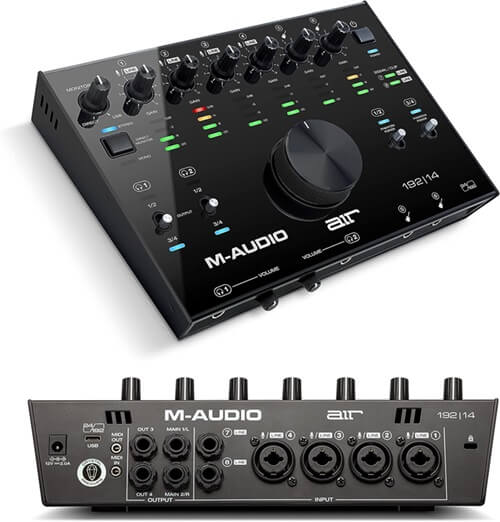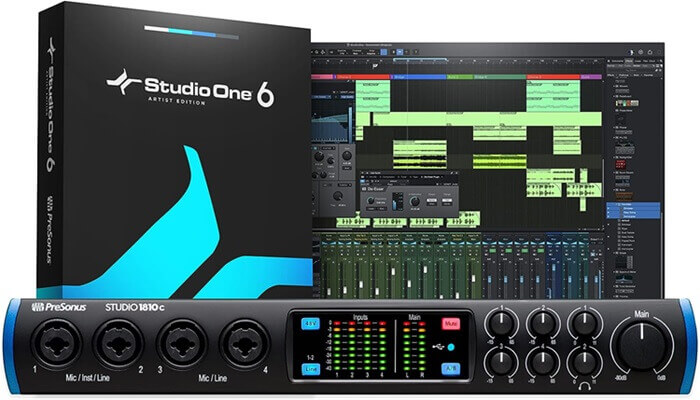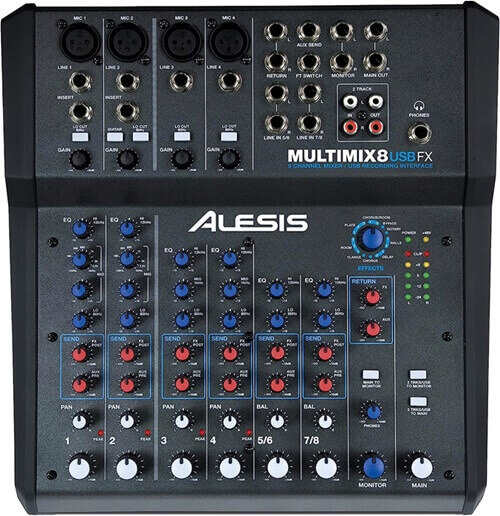In the dynamic realm of audio production, where precision and clarity are paramount, the choice of an audio interface serves as the cornerstone for capturing and crafting the perfect sound. Musicians, producers, and audio enthusiasts alike understand the pivotal role that an 8-channel audio interface plays in elevating their creative endeavors to new heights. As the demand for multi-track recording and high-fidelity audio processing continues to surge, the quest for the best 8-channel audio interface becomes more critical than ever.
This comprehensive guide is designed to navigate you through the intricacies of the audio interface landscape, unveiling the top contenders that stand out in the realm of 8-channel interfaces. Whether you’re a seasoned studio professional seeking unparalleled versatility or a budding artist eager to explore the sonic possibilities, our exploration of these audio powerhouses will help you make an informed decision.
Embark on a journey with us as we delve into the features, performance metrics, and user experiences that define the Best 8-Channel Audio Interfaces in the market. From cutting-edge technological innovations to user-friendly interfaces that seamlessly integrate into diverse recording setups, we’re here to unravel the nuances and highlight the unique strengths of each contender. Before we delve into the features of each one, check out our “Buying Guide“ for audio interfaces.
Let’s get into its details…
Also Check:
Outline
ToggleBest 8-Channel Audio Interfaces Table
| Best 8-Channel Audio Interfaces | Input Options | Output Options | Audio Quality | Connectivity | Buy Now |
|---|---|---|---|---|---|
| Behringer 8-Channel Audio Interfaces | 8 x XLR/TRS | 8x ¼ "" TRS, line outputs 2x ¼ "" TRS, main outputs 2x ¼ "" TRSstereo, headphone outputs" | Audiophile 24-Bit/96 kHz resolution | USB type B | Check On Amazon |
| Focusrite 8-Channel Audio Interfaces | analogue (8), ADAT (8), S/PDIF (2) | analogue (4), headphones (2 x 2), S/PDIF (2) | Hitmaker Expansion | USB type C | Check On Amazon |
| M-Audio 8-Channel Audio Interfaces | (4) XLR+¼” TRS combo inputs, (2) ¼” line inputs, (2) all-new ¼” instrument inputs, | ¼” main outputs, and (2) ¼” assignable outputs. | ultra-pristine A/D, Crystal preamps , with 24-bit/192kHz resolution. | USB type C | Check On Amazon |
| PreSonus 8-Channel Audio Interfaces | 4 dedicated line inputs | 2 ¼” TRS balanced DC coupled main outputs 4 ¼” TRS balanced DC coupled line outputs | - | USB-C | Check On Amazon |
| Roland 8-Channel Audio Interfaces | 10 (8 x Mic/Line/Instrument, 2 x Coaxial) | 10 (8 x Line, 2 x Coaxial) | ASIO Drivers, DSP, MIDI Support, with 24-bit/192 kHz Audio Resolution | - | Check On Amazon |
| Alesis 8-Channel Audio Interfaces | 4- XLR Inputs w, 4 - Line Inputs | Main and headphone outputs | Channel EQs, supports 16-bit at 44.1/48 kHz resolution | - | Check On Amazon |
Best 8-Channel Audio Interfaces Reviews
1. Behringer 8-Channel Audio Interfaces

The interface boasts a broad frequency response, delivering audiophile-grade 24-bit/96 kHz resolution for professional audio quality. It also includes MIDI I/O with 5-pin DIN connectors, allowing seamless communication with MIDI devices and enhancing control within your studio setup.
It provides broad support for digital audio interfaces, including ADAT, S/PDIF, and S/MUX, ensuring compatibility with a wide array of equipment and setups. It readily integrates with popular recording software like Avid Pro Tools, Ableton Live, Steinberg Cubase, and others, making it a seamless addition to your existing creative process.
Technical Specifications:
| Features | Description |
| Audio Resolution | 24-Bit/96 kHz. |
| Number of Channels | 8 |
| Mic Preamps | 8 Midas-designed with +48 V phantom power. |
| Input Types | XLR, 1/4″ TRS (Line/Instrument). |
| Output Types | 1/4″ TRS (Line and Main), Stereo Headphone. |
| Digital Audio I/O | Coaxial RCA (S/PDIF), Optical TOSLINK (ADAT, S/PDIF). |
| MIDI I/O | 5-pin DIN (1 In, 1 Out). |
| Direct Monitoring | Zero-latency monitoring of analog inputs. |
Pros:
- Affordable pricing.
- Good audio quality for the price.
- Easy setup, minimal software or driver hassles.
- Versatile for various recording scenarios.
- Improved build quality (UMC202HD).
- Direct monitoring for zero latency.
Cons:
- Limited headphone output volume.
2. Focusrite 8-Channel Audio Interfaces

An audio interface is equipped with high-quality preamps. The mic preamps are among the best-performing and offer exceptional headroom and signal clarity. With the switchable Air mode, you can enhance vocal recordings. The interface boasts audiophile-grade 24-bit/192kHz resolution, ensuring that your recordings retain all their sonic details and nuances.
It’s compatible with a wide range of recording software, making it easy to integrate into your existing studio setup. It comes with software and sound content, including the Hitmaker Expansion, allowing you to kickstart your recording and music creation immediately.
Technical Specifications:
| Feature | Description |
| Supported Software | All the Software. |
| Connectivity Technology | USB Type C. |
| Number of Channels | 8 |
| Inputs |
– Inputs 1 and 2: “Combo” input sockets for microphones, instruments, or line-level signals with XLR and ¼” (6.35 mm) jacks. Suitable for both XLR and jack plugs. – Inputs 3 & 4: XLR Combo type input sockets for mic or line-level signals. – TOSLINK connector for eight channels of digital audio in ADAT format at 44.1/48 kHz sample rate. |
| Line Outputs | – Four balanced analog line outputs on ¼” (6.35 mm) jack sockets. Supports both TRS (balanced) and TS (unbalanced) jack plugs. – 2 Outputs can be used for driving alternative speakers. |
| MIDI I/O | Standard 5-pin DIN sockets for connecting external MIDI equipment. It also functions as a MIDI interface. |
| Phantom Power | +48V |
| Resolution | Up to 24-bit/192kHz. |
Pros:
- High-quality preamps.
- Switchable Air mode for enhanced vocal recordings.
- Audiophile-grade 24-bit/192kHz resolution.
- MIDI connectivity.
- Compatible with a wide range of recording software.
- Comes with software and sound content, including the Hitmaker Expansion.
Cons:
- Requires an external power supply for operation.
- Initial setup and routing configuration can be confusing for Linux users.
3. M-Audio 8-Channel Audio Interfaces

It boasts 24-bit/192kHz resolution, ensuring professional-grade recording quality. The transparent Crystal preamps and ultra-pristine A/D converters guarantee exceptional audio fidelity. This interface offers 5-pin MIDI In/Out connections, allowing you to link up with external MIDI gear.
It comes bundled with a selection of pro software, including MPC Beats, Ableton Live Lite, Touch Loops, the Creative FX Collection, Xpand!2, Mini Grand, DB33, Strike, Hybrid3, and Revalver, making it an all-in-one solution for your music production needs.
Technical Specifications:
| Feature | Decsription |
| Supported Software | MPC Beats, Ableton Live Lite, Touch Loops, plus the Creative FX Collection, Xpand!2, Mini Grand, DB33, Strike, Hybrid3, and Revalver. |
| Connectivity Technology | USB C |
| Number of Channels | 8 |
| Audio Resolution | 24-bit/192kHz. |
| Preamps | Transparent Crystal Preamps. |
| Inputs |
– 4 XLR+¼” TRS combo inputs. – 2 ¼” instrument inputs. – 2 ¼” line inputs. |
| Outputs |
– Main Outputs, L and R (balanced 1/4” TRS). – Headphone Output (1/4” TRS). |
| MIDI Connectivity | 5-pin MIDI In/Out. |
| Included Software | MPC Beats, Ableton Live Lite, Touch Loops, plus the Creative FX Collection, Xpand!2, Mini Grand, DB33, Strike, Hybrid3, and Revalver. |
Pros:
- High-quality audio preamplifiers.
- Low latency for clean recording.
- Powerful headphone outputs.
- Ability to handle multiple audio sources.
- VU LED meters for precise monitoring.
- USB/Direct knob for control.
- Compatibility with Mac and Windows.
Cons:
- Concerns about device temperature at high sample rates.
- Slight confusion about output options with external processors.
4. PreSonus 8-Channel Audio Interfaces

When it comes to audio quality and precision, the Studio excels. It features four XMAX Class A mic preamps, known for their pristine and transparent sound quality, ensuring that every detail of your sound source is faithfully captured. The high-resolution 24-bit/192 kHz audio capability guarantees that your audio is recorded with exceptional fidelity and clarity.
The Studio offers eight channels of ADAT Optical input (four channels at 96 kHz), S/PDIF digital I/O, and MIDI In/Out, ensuring compatibility with a wide range of external instruments and controllers. It seamlessly integrates with most macOS, Windows, iOS, and iPadOS audio recording software. To enhance your production capabilities, the Studio comes bundled with the Studio Magic Suite of software, featuring tutorials, sound libraries, virtual instruments, and effects plug-ins in various formats.
Technical Specifications:
| Features | Description |
| Audio Resolution | 24-bit/192 kHz. |
| Dynamic Range | 114 dB |
| Inputs |
– Four Combo Mic/Instrument/Line Inputs (XLR and 1/4″). – Four 1/4″ Line Inputs. – 8 channels of ADAT Optical input (4 channels at 96 kHz). – S/PDIF digital I/O. – MIDI In/Out. |
| Preamps | Four XMAX Class A Mic Preamps. |
| Main Outputs |
– Two 1/4″ TRS Balanced DC-Coupled Main Outputs. – Front-Panel Level Control. – Dedicated Mute and Mono Buttons. |
| Line Outputs | Four 1/4″ TRS Balanced DC-Coupled Line Outputs. |
| Monitoring |
-Flexible Routing with Zero-Latency Monitor Mixing. -Control-Room Integration with Studio One Artist. -UC Surface Software for Monitor Mix Control. |
| Compatibility | macOS, Windows, iOS, and iPadOS. |
Pros:
- High-Resolution Audio Quality (24-bit/192 kHz) with a 114 dB dynamic range.
- Included USB-C to USB-C and USB-C to USB-A cables for flexible compatibility.
- Premium XMAX Class A mic preamps for exceptional sound quality.
- Versatile inputs and outputs.
- Intuitive control and monitoring with LED metering and zero-latency monitor mixing.
- Expansive connectivity options with ADAT Optical, S/PDIF, and MIDI I/O.
- Includes Studio One Artist license and Studio Magic Suite software.
Cons:
- Requires a computer or device for operation.
5. Roland 8-Channel Audio Interfaces

Roland’s 8-channel audio interface offers flexibility with eight premium mic preamps and ten inputs/outputs. It provides high-resolution 24-bit/192 kHz audio quality and seamless compatibility with major DAWs on both Mac and PC. The AUTO-SENS function simplifies setup, and it features balanced XLR and 1/4-inch TRS inputs, coaxial I/O, and dedicated headphone monitoring.”
Technical Specifications:
| Features | Description |
| Number of Inputs | 10 (8 x Mic/Line/Instrument, 2 x Coaxial). |
| Number of Outputs | 10 (8 x Line, 2 x Coaxial). |
| Mic Preamps | 8 Premium Mic Preamps with +48V Phantom Power. |
| Input Connectors | 8 x XLR, 8 x 1/4 inch TRS (Balanced). |
| Output Connectors | 8 x 1/4 inch TRS (Balanced), 2 x Coaxial. |
| Headphones Output | Stereo 1/4 inch Jack. |
| Maximum Resolution | 24-bit/192 kHz. |
| Compatibility | Windows (ASIO, WDM), Mac (Core Audio). |
Pros:
- Excellent performance with two units combined for 16 ports.
- Compatibility with ASIO drivers.
- High-quality mic preamps for exceptional sound clarity.
- High-resolution 24-bit/192 kHz audio.
- Channel-specific noise gate and compression.
- Low latency for software synth triggering.
- MIDI support
- Sturdy and durable build quality.
Cons:
- Dropouts during simultaneous recording and software synth triggering.
- Limited by USB 2.0 interface in terms of data speed.
6. Alesis 8-Channel Audio Interfaces

For output flexibility, the mixer provides separate 1/4″ main and monitor outputs, allowing you to connect to PA speakers, active monitors, amplifiers, and recording devices. Additionally, it includes a headphone output with independent level control, making it suitable for monitoring and recording.
It includes XLR inputs with gain trim for precise control over your microphone inputs. The mixer also offers switchable high-pass filters to reduce low-frequency rumble, handling noise, and wind noise, ensuring clean audio capture. Channel EQs are provided with sweepable mid-range controls on two bands on 5 – 8 channels, allowing you to fine-tune your sound. This results in outstanding audio quality, and the device supports 16-bit recording at 44.1/48 kHz resolution, guaranteeing excellent sound fidelity for your recordings.
Technical Specifications:
| Feature | Specification |
| Channels | 8 |
| Input Types |
– 1/4″ Line-Level Inputs. – High-Impedance Input for Electric Guitar and Bass (DI). – XLR Inputs with 48V Phantom Power. |
| Outputs |
– 1/4″ Main Outputs. – 1/4″ Monitor Output. – Headphone Output with Independent Level Control. |
| Recording Resolution | 16-bit, 44.1/48 kHz Stereo USB Output. |
| Built-In Effects | 15 DSP Effects with Channel FX Sends (Pre and Post EQ) and Master FX Return Level. |
| Software Suite | AKAI Professional MPC Beats. |
| Compatibility | Class Compliant USB Interface for Mac and PC. |
| Connectivity | USB |
Pros:
- Intuitive controls and good built-in effects.
- High-quality sound.
- Compact and solid build.
- Valuable features like sweepable mids, reverb, and external effects send.
- Affordable
- Suitable for small ensemble live use.
Cons:
- Lacks solo and mute buttons on channels.
- No volume control for digital audio input.
- Built-in digital audio effects are somewhat limited.
- Limited to 44.1/48 kHz 16-bit stereo digital input and output via USB.
Buying Guide for Best 8-Channel Audio Interfaces
1. Input/Output Options
Start by assessing your recording requirements. How many simultaneous inputs do you need? Consider the types of sources you’ll be recording, such as microphones, instruments, or line-level devices. Ensure that the audio interface offers a sufficient number of inputs, both XLR and 1/4-inch options, to accommodate your recording sources.
Evaluate the availability of output options. Check for the number and types of output connections, including 1/4-inch outputs, headphone outputs, and digital outputs if needed.
If you plan to expand your setup in the future, consider interfaces that offer ADAT or other expansion options to accommodate additional inputs and outputs.
2. Audio Quality
One of the most critical factors in choosing an audio interface is audio quality. To ensure your recordings are of the highest quality, prioritize models equipped with high-resolution audio converters.
Look for interfaces with a high bit depth (e.g., 24-bit) and a high sample rate (e.g., 96 kHz or 192 kHz). Higher bit depth and sample rate provide better fidelity and detail in your recordings. Check for low noise levels and a wide dynamic range, which are indicators of better audio quality.
3. Connectivity Options
Examine the connectivity options provided by the audio interface. In addition to USB connections, some models offer Thunderbolt, FireWire, or PCIe connections. Choose the one that suits your computer and provides the necessary bandwidth for your audio needs.
Check for MIDI connectivity if you need to connect MIDI controllers, synthesizers, or other MIDI devices.
4. Compatibility
Before making a purchase, it’s crucial to confirm that the audio interface is compatible with your operating system. Check if it supports your version of Windows, macOS, or other platforms you may be using.
Additionally, look for reliable driver support. Well-maintained drivers are essential for ensuring the interface works seamlessly with your computer. Check if the manufacturer provides regular updates for compatibility with the latest operating system versions.
Ensure the interface is compatible with your preferred Digital Audio Workstation (DAW) software. Most interfaces work with major DAWs, but it’s always a good idea to verify compatibility.
5. Number of Preamps
If you plan to record multiple microphones simultaneously, consider the number of preamps available on the audio interface. Preamps are essential for boosting the level of your microphones and ensuring clean and clear recordings.
Some interfaces offer a combination of preamps and line inputs, allowing you to record a variety of sources with or without preamplification.
6. Portability
Think about whether you need a portable audio interface for on-the-go recording or if a desktop unit will suffice for your studio setup. Portable interfaces are compact and often bus-powered, making them ideal for field recording and mobile setups.
Consider the physical size of the interface to ensure it fits comfortably in your workspace or recording environment.
8-Channel Audio Interfaces – FAQs
Ans: An 8-channel audio interface is a piece of hardware that allows you to connect and record audio from up to eight different sources simultaneously. It’s commonly used in music production, live sound, and other audio recording applications.
Ans: Yes, 8-channel audio interfaces are compatible with most popular DAW software.
Ans: The portability of 8-channel audio interfaces varies. Some are compact and suitable for mobile recording, while others are rack-mounted and more suitable for studio setups.
Conclusion
- Alesis 8 channel audio interface as a budget-friendly and compact studio mixer, with various inputs, built-in effects, and USB connectivity. It’s suitable for individuals on a budget seeking a capable mixer for live sound and home studio recording purposes.
- For those working with multiple sound sources in a studio or live sound setting. Behringer 8-channel audio interface offers extensive connectivity options with its 8 XLR/TRS inputs. ¼” TRS line outputs, two ¼” TRS main outputs, and two ¼” TRS stereo headphone outputs, ensuring comprehensive control over your audio routing.
- Focusrite 8-channel audio interface is ideal for users who prioritize portability and ease of transportation. The interface boasts audiophile-grade 24-bit/192kHz resolution. Compatible with a wide range of recording software, making it easy to integrate into your existing studio setup.
Do share your queries regarding its selection and usage with us in the comments section below. We’ll respond promptly and help you to resolve your queries.

